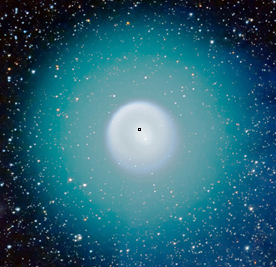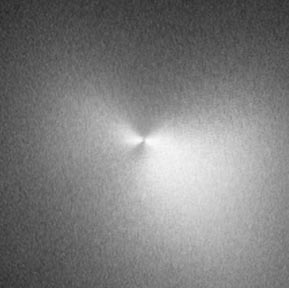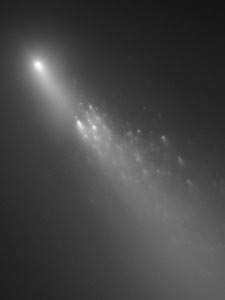| Click here to get a sky chart and simple instructions for finding Comet Holmes in the sky. |

Comet Holmes, 17P, taken on November 1, 2007, with an A&M 105-mm f/5 refractor at f/5 with Borg 0.85x compressor/field flattener and a Canon 20Da camera at ISO400. This is a composite of exposures ranging from 7 seconds to 4 minutes. The tiny black square indicates the area around the nucleus imaged three days later by the Hubble Space Telescope. Click on the image for a larger view.
Alan Dyer
One possible explanation that's almost certainly not correct is that it was struck by an asteroidal fragment. Although this comet occupies the realm between Mars and Jupiter, its orbital inclination (19°) actually keeps 17P/Holmes well separated from most denizens of the asteroid belt. Moreover, counting the outbursts that occurred during and after its discovery in 1892, three collisions would be needed to explain all the activity.
Another unlikely scenario, proposed by the late Fred Whipple in 1984, is that the nucleus was accompanied through space by one or more satellites that "reentered" and released a torrent of dust and gas when they struck the main mass in 1892.
Other comets have erupted like this before — Comet 41P/Tuttle-Giacobini-Kresak's performance in 1973 comes to mind — though not as dramatically. Most likely, repeated warmings by the Sun caused a dusty, ice-free "crust" to form on the nucleus, sealing the interior. Over time the pressure beneath this seal steadily grew as once-frozen ice became gas, eventually breaking through and sending large chunks of crust flying into space that quickly disintegrated into microscopic dust.

Acquired on November 4, 2007, this Hubble Space Telescope view of Comet Holmes's inner coma is 10″ wide, about 7,500 miles at the comet's distance. Even HST's powerful camera cannot resolve the 2-mile-wide nucleus. It's also apparent that the comet had not broken apart.
NASA / ESA / Harold Weaver (JHU/APL)
At least that's the leading hypothesis. Realistically, we may never know the cause. This comet's behavior, particularly the perfectly spherical outer halo, has confounded even the experts. Remarkably, 17P/Holmes has mimicked almost perfectly the behavior seen during its discovery 115 years ago. "I have never in my experience as a cometary scientist seen such a symmetric structure in emitted material," admits Carey Lisse of Johns Hopkins University's Applied Physics Laboratory.
Colleague Harold Weaver adds, "That offset blob was very unusual. Some kind of large chunk must have come off and disintegrated." Comet theorist Zdenek Sekanina (Jet Propulsion Laboratory) estimates that this "megaburst," most likely triggered late on October 23rd (Universal Time), shot 100 million tons of dust into space. To put this in perspective, Mount St. Helens unleashed a 500-million-ton ash cloud during its catastrophic 1980 eruption.
Studies with ground-based observatories show that Comet Holmes has been emitting a rather typical combination of water and other compounds. Weaver, Lisse, and others managed to commandeer the Hubble Space Telescope for one orbit's observations on each of three nights in late October and early November. The blandness of these images argues that the nucleus didn't break apart wholesale, as was the fate of Comet 73P/Schwassmann-Wachmann 3 in April 2006.

Fragment G, one of several large castoffs created during the breakup of periodic Comet 73P/Schwassmann-Wachmann 3 in April 2006, has itself disintegrated into scores of icy bits in this Hubble Space Telescope view.
NASA / ESA / H. Weaver (JHU/APL) / M. Mutchler & Z. Levay (STScI)
Follow-up infrared observations with the Spitzer Space Telescope on November 13th should provide some compositional constraints on the vast cloud of dust particles that made Comet Holmes appear so bright.
"The Spitzer spectra show that the dust coming off the nucleus is fine-grained silicates, with a mineralogy similar to Hale-Bopp's," says William Reach (Caltech). The observations, spanning wavelengths of 5 to 40 microns, targeted the area closest to the nucleus. Unfortunately, Spitzer didn't get to check out the blob of matter seen moving outward soon after the outburst because, Reach adds, "at the time of our proposal we didn't know where that stuff was going to be!"
One clue to what has triggered the outburst now — and not, say, during its previous appearance in 1999 — may be its vacillating perihelion distance. As master comet chronicler Gary Kronk noted recently in an online posting, "The comet's orbit was altered by Jupiter during December 1908 so that the perihelion distance increased from 2.12 AU to 2.34 AU. The comet was lost until 1964 and it remained faint during that apparition."
"An approach to Jupiter during April 1968 decreased the perihelion distance back to 2.16 AU," Kronk continues, "but no outbursts were observed at any apparition between 1972 and 2000. Another approach to Jupiter in January of 2004 decreased the perihelion distance to 2.05 AU, [followed by] an outburst at the very next apparition."
Coincidence? Perhaps not!
 0
0
Comments
You must be logged in to post a comment.